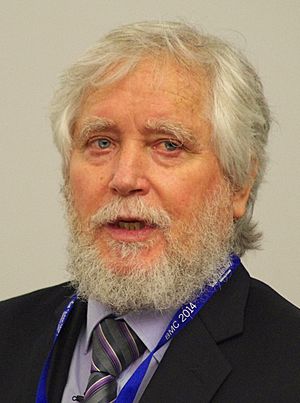Endre Szemerédi facts for kids
Quick facts for kids
Endre Szemerédi
|
|
|---|---|

Szemerédi in 2014
|
|
| Born | August 21, 1940 Budapest, Kingdom of Hungary
|
| Nationality | Hungarian, American |
| Education | Eötvös Loránd University (BS) Moscow State University (MS, PhD) |
| Awards | Abel Prize (2012) Széchenyi Prize (2012) Rolf Schock Prizes (2008) Leroy P. Steele Prize (2008) George Pólya Prize (1975) Alfréd Rényi Prize (1973) Member of the National Academy of Sciences |
| Scientific career | |
| Fields | Combinatorics Computer science Mathematics Theoretical computer science |
| Institutions | Rutgers University |
| Doctoral advisor | Israel Gelfand |
| Doctoral students | Jaikumar Radhakrishnan Gábor N. Sárközy |
Endre Szemerédi (born August 21, 1940) is a famous Hungarian-American mathematician and computer scientist. He works in areas like combinatorics and theoretical computer science. Combinatorics is a branch of mathematics that studies how to count, arrange, and combine things. Theoretical computer science uses math to understand how computers work and solve problems.
Since 1986, he has been a professor of computer science at Rutgers University in New Jersey. He is also a professor emeritus at the Alfréd Rényi Institute of Mathematics in Hungary.
Szemerédi has won many important awards for his work, including the Abel Prize in 2012. He has made big discoveries in math and computer science. Some of his well-known ideas include Szemerédi's theorem and the Szemerédi regularity lemma.
Contents
Early Life and Education
Endre Szemerédi was born in Budapest, Hungary. His parents wanted him to become a doctor. He started medical school, but he soon realized it wasn't the right path for him. He felt the responsibility was too great.
Instead, he chose to study mathematics. He attended the Eötvös Loránd University in Budapest. Later, he earned his PhD from Moscow State University. His main teacher and guide for his PhD was Israel Gelfand, a very respected mathematician.
Academic Journey
Professor Szemerédi has taught at Rutgers University in the United States since 1986. He has also been a visiting professor at several other well-known universities. These include Stanford University, McGill University, and the University of Chicago. This means he spent time teaching and doing research at these places.
Important Discoveries
Endre Szemerédi has written over 200 scientific papers. These papers cover topics like discrete mathematics, computer science, and geometry. He is most famous for his proof of Szemerédi's theorem in 1975.
Szemerédi's Theorem
This theorem solved an old puzzle from mathematicians Paul Erdős and Pál Turán. Imagine you have a very long list of numbers. If these numbers are "dense" enough, Szemerédi proved that you will always find patterns within them. These patterns are called "arithmetic progressions." An arithmetic progression is a sequence of numbers where the difference between consecutive terms is constant, like 2, 4, 6, 8 (where the difference is 2) or 5, 10, 15, 20 (where the difference is 5). His theorem shows that you can find these patterns of any length.
Szemerédi Regularity Lemma
As part of proving his theorem, Szemerédi created a tool called the Szemerédi regularity lemma. This lemma is very important in combinatorics. It helps mathematicians understand the structure of very large and complex networks, called graphs. It's like being able to break down a huge, messy drawing into smaller, more organized parts. This lemma is now used in many different areas of math and computer science.
Other Key Contributions
Szemerédi also worked on other significant theorems. These include the Szemerédi–Trotter theorem, which deals with how points and lines can be arranged. He also contributed to the Hajnal–Szemerédi theorem in graph theory, which is about dividing a graph into equal parts.
With other mathematicians like Miklós Ajtai and János Komlós, he helped solve problems related to Ramsey numbers and created efficient ways to sort information. He also helped prove the crossing number inequality. This inequality helps understand how many times lines must cross when drawing a graph.
Awards and Honors
Endre Szemerédi has received many awards for his amazing work.
- Alfréd Rényi Prize (1973)
- George Pólya Prize (1975)
- Leroy P. Steele Prize (2008)
- Rolf Schock Prizes (2008)
- Széchenyi Prize (2012)
- Abel Prize (2012)
- Hungarian Order of Saint Stephen (2020)
He is a member of the Hungarian Academy of Sciences and the United States National Academy of Sciences. These are very high honors for scientists. He is also a member of the Institute for Advanced Study in Princeton, New Jersey.
In 2012, he received the Abel Prize. This prize is one of the highest honors in mathematics, often called the "Nobel Prize of mathematics." He won it for his "fundamental contributions to discrete mathematics and theoretical computer science." The prize committee said his work helped bring combinatorics to the forefront of mathematics. Szemerédi himself said that the award was not just for him, but for the entire field of mathematics and for Hungarian mathematicians.
Conferences and Celebrations
In August 2010, a special conference was held in Hungary to celebrate Endre Szemerédi's 70th birthday. Mathematicians from all over the world gathered to honor his achievements.
A book called An Irregular Mind was also published for his 70th birthday. It is a collection of papers written by other mathematicians, celebrating his important discoveries. Another conference, called the "Third Abel Conference," was also held to celebrate his work.
Personal Life
Endre Szemerédi is married to Anna Kepes. They have five children: Andrea, Anita, Peter, Kati, and Zsuzsi.
See also
 In Spanish: Endre Szemerédi para niños
In Spanish: Endre Szemerédi para niños


